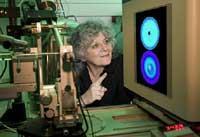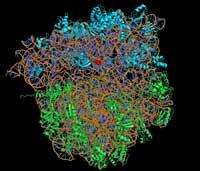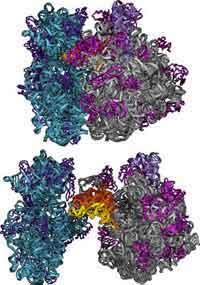Chemical novel for those who studied the atomic structure and the functioning of the ribosomes
2009/10/07 Kortabitarte Egiguren, Irati - Elhuyar Zientzia
Three researchers will receive this year the Nobel Prize in Chemistry for studying the structure and functioning of the ribosomes at atomic level. Venkatraman Ramakrishnan, USA, Thomas A. Steitz and Ada E of Israel. The winners are Yonath.
Ribosomes participate in the synthesis of proteins. The genetic code necessary for protein synthesis is collected by a messenger RNA, which forms protein chains with this information and with the amino acids provided by the transfer RNA molecules. They are the essential proteins to live.
X-ray crystallography

To know the functioning of a molecule, it is essential to know precisely its atomic structure. The same occurs with more complex structures than molecules, such as ribosomes. In this sense, Ada E began in the late 1970s. Yonath to this work. That is, to study the atomic structure of the ribosomes. For this purpose he used X-ray crystallography. This technique consists of the emission of X-rays against crystallized ribosomes. These X-rays when colliding with the ribosome crystal are dispersed, representing millions of points in the eye of digital cameras or in the CCD detector. Analyzing this image composed of millions of points, researchers can know where each atom is located in the ribosome. However, ribosomes are complex structures formed mainly by proteins and nucleic acids, whose atomic structure is not an easy task to determine. It consists of two subunits, a small subunit and a large subunit. Each of these subunits has thousands of atoms. D. D. Ada Yonath wanted to know the exact location of each of them.
To achieve this goal, several ribosomes began to crystallize and to obtain these images formed by points. At the beginning of the 90's he was able to observe the position of the glass atoms of a ribosome. However, a problem was found: to know precisely the atomic structure of the ribosome it was necessary to know the phase angle of each dispersed ray. In fact, this mathematical information indicates, among other things, the position of atoms in crystal.

A common method for knowing these phase angles is the immersion of these crystals in heavy atoms like mercury. These heavy atoms adhere to the surface of the crystal and, therefore, by comparing the images formed by heavy atoms and without heavy atoms, scientists know these phase angles. However, since ribosomes are large molecules, the immediate determination of the phase angle by binding to them heavy atoms was virtually impossible.
Thomas Steitz solved the problem. It used several images of the ribosomes collected with an electronic microscope and determined the arrangement of the atoms of the ribosomes. Unfortunately, the images did not have a very good resolution and could not identify atoms individually. However, with the help of these figures and heavy atoms, he determined the phase angles.
Once the problem of the phase angle was overcome, only the crystals were improved and data collection increased to improve the image accuracy. The three winners of this year achieved it immediately. In August and September 2000, various crystalline structures were presented that allowed interpreting the atomic structure. Thomas Steitz managed to determine the atomic structure of the great subunit of the ribosome of the archaeologist Haloarcula marismortui. D. D. Ada For their part, researchers Yonath and Venkatraman Ramakrishan obtained the structure of the small subunit of the ribosome of the Thermus thermophilus bacteria. Therefore, they saw that it was possible to determine at atomic level the structure and functioning of the ribosomes.
Search for new antibiotics
On the other hand, the exhaustive knowledge of the structure and functioning of the ribosoma opens new ways. In fact, many antibiotics are associated with bacterial ribosoma, preventing its protein production. In addition, many of these bacteria have developed resistance to these drugs. Therefore, it is essential to find new ways.
In the future, and after the steps taken by these three researchers, better antibiotics can be designed in the fight against bacteria. In fact, the three have focused on investigating how antibiotics are associated with ribosomes, and there are already organizations that use ribosomal structures to develop new antibiotics.

Gai honi buruzko eduki gehiago
Elhuyarrek garatutako teknologia





